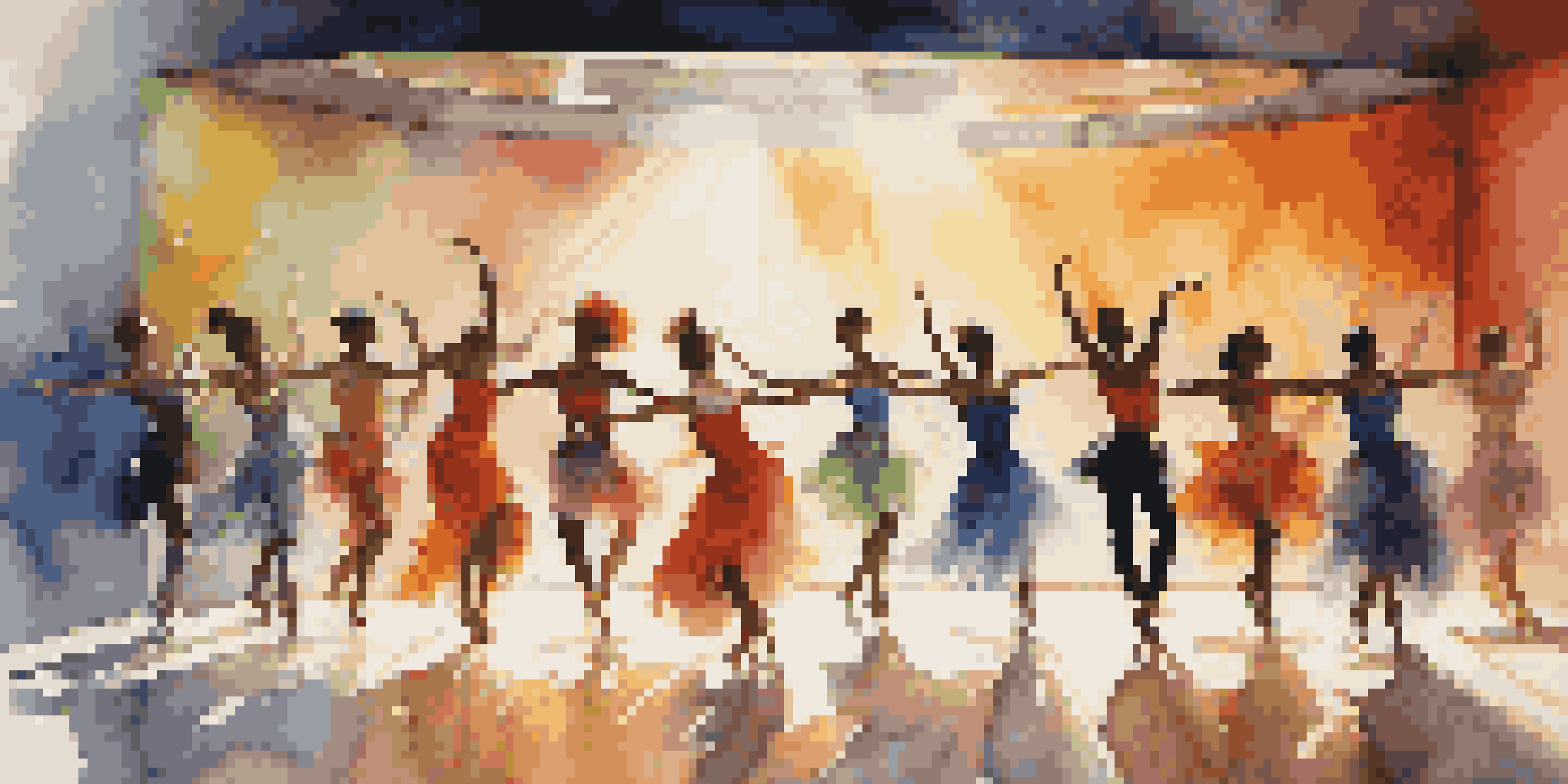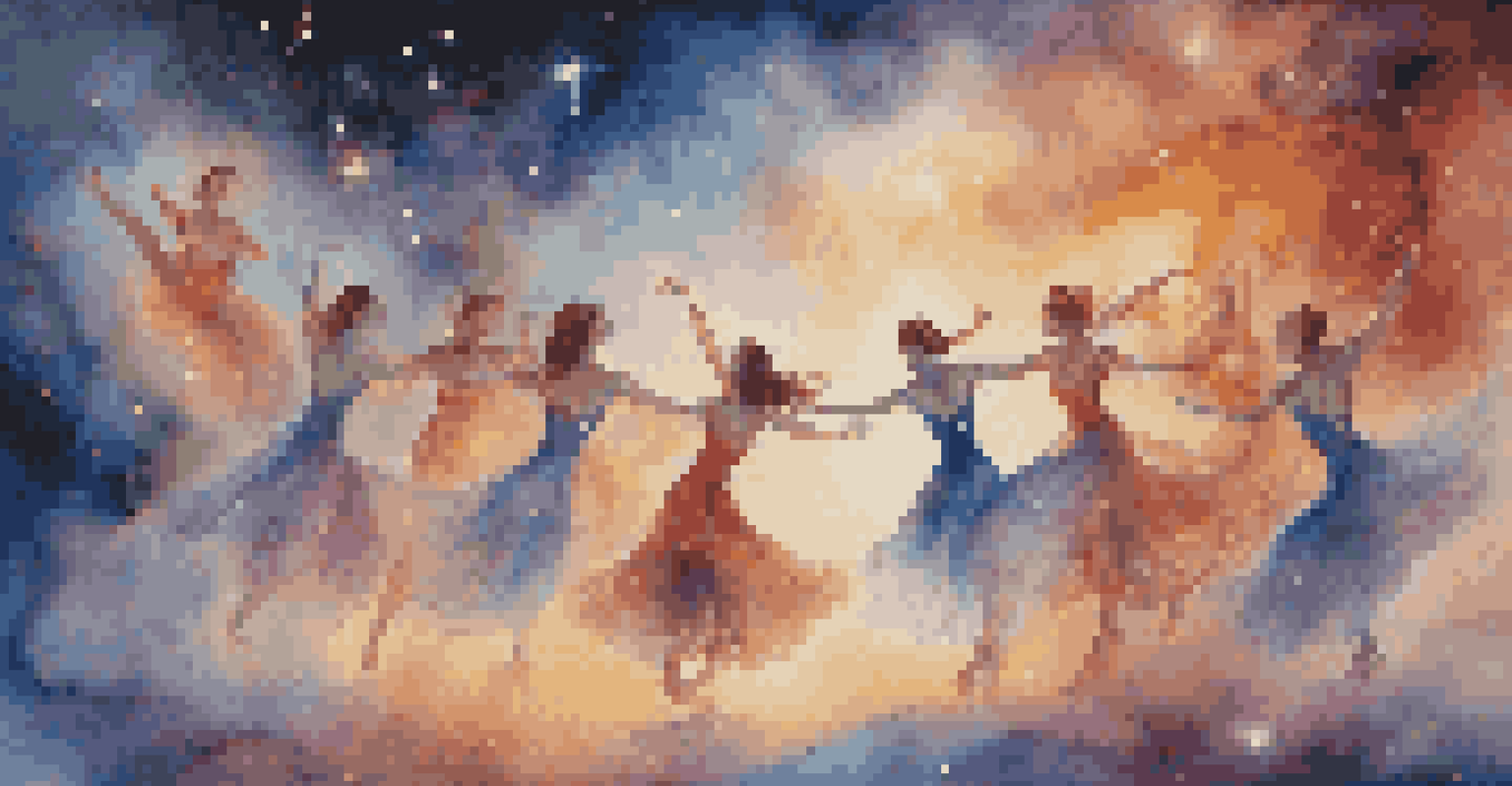The Intersection of Dance and Technology in Modern Cinema

The Evolution of Dance in Film: A Brief Overview
Dance has always played a crucial role in cinema, serving as a powerful storytelling tool. From the graceful movements of classic musicals to the energetic choreography of modern blockbusters, dance evolves alongside film technology. With each new advancement, filmmakers have found innovative ways to integrate dance into their narratives, capturing audiences' hearts and imaginations.
Dance is the hidden language of the soul.
Consider iconic films like 'Singin' in the Rain' and 'West Side Story,' where dance not only entertains but elevates the emotional stakes. Fast forward to contemporary movies, and we see a blend of traditional dance forms with cutting-edge visual effects, creating a fresh experience for viewers. This evolution highlights the dynamic relationship between dance and film, setting the stage for further exploration.
As technology continues to advance, it brings new opportunities and challenges for choreographers and filmmakers alike. The intersection of dance and technology not only enhances the visual appeal but also expands the creative possibilities in storytelling. Understanding this evolution helps us appreciate the artistry behind the scenes.
Technology's Role in Modern Dance Choreography
In recent years, technology has transformed how choreographers create and present dance. Digital tools like motion capture and animation allow artists to visualize their ideas in unique ways. For instance, choreographers can use software to simulate dance movements before they hit the stage, refining their vision and ensuring a seamless performance.

Moreover, technology enables collaboration across distances, connecting artists from different parts of the world. This kind of connectivity has led to innovative choreography that blends diverse cultural influences, creating rich, hybrid forms of dance. The result is a vibrant tapestry of movement that resonates with global audiences.
Dance and Technology Unite
The integration of technology, like CGI and AR, is transforming the way dance is created and experienced in film.
Additionally, technology has opened doors for new performance formats. Dancers can now perform in virtual reality environments or alongside animated characters, pushing the boundaries of traditional dance. This integration of technology not only enhances artistic expression but also engages viewers in exciting new ways.
The Impact of CGI on Dance Sequences
Computer-generated imagery (CGI) has revolutionized how dance sequences are conceptualized and executed in film. By blending live-action performances with CGI, filmmakers can create visually stunning dance sequences that would be impossible to achieve otherwise. For example, movies like 'Avatar' and 'The Greatest Showman' showcase how CGI can enhance dance, making it a spectacle for the eyes.
Technology is best when it brings people together.
The use of CGI allows for creative freedom, enabling choreographers to explore fantastical elements that enhance the storytelling. Imagine a dance number set against a backdrop of swirling galaxies or a performance where dancers interact with animated environments. This synergy between dance and technology captivates audiences, making the experience unforgettable.
However, the reliance on CGI also raises questions about authenticity and the essence of dance. As filmmakers embrace technology, they must strike a balance between enhancing visuals and maintaining the raw, emotive power of live performance. This ongoing dialogue shapes the future of dance in cinema.
Augmented Reality: A New Dimension for Dance
Augmented reality (AR) is another technological advancement that is making waves in the dance world. By overlaying digital elements onto the real world, AR creates immersive experiences that engage audiences like never before. Dancers can perform alongside virtual characters or in environments that change dynamically, creating a multi-sensory experience.
This technology is especially appealing for live performances, where audiences can use their devices to unlock additional layers of storytelling. Imagine attending a dance show where your phone reveals hidden choreography or interactive elements on stage. This level of engagement transforms the way audiences perceive and connect with dance.
Social Media Amplifies Dance Films
Platforms such as Instagram and TikTok play a crucial role in promoting dance films, allowing direct engagement between artists and audiences.
As AR technology continues to evolve, it presents new opportunities for experimentation and innovation. Dancers and choreographers can explore the interplay between the physical and digital realms, pushing boundaries and reimagining traditional forms. The potential for storytelling through AR is limitless, paving the way for exciting future performances.
The Role of Social Media in Dance Film Promotion
Social media has become an essential platform for promoting dance films and performances. Platforms like Instagram, TikTok, and YouTube allow filmmakers and dancers to showcase their work to a global audience. These channels provide a space for creativity, where snippets of dance sequences can go viral, generating buzz and excitement around upcoming projects.
Moreover, social media enables direct interaction between artists and their fans. Dancers can share behind-the-scenes content, engage with their audience, and even collaborate with fans through challenges or dance trends. This level of engagement fosters a sense of community and connection, amplifying the reach of dance films.
However, the fast-paced nature of social media also presents challenges. With so much content vying for attention, standing out requires creativity and originality. Filmmakers must continually find new ways to captivate audiences, often relying on innovative visuals and compelling storytelling to cut through the noise.
The Future of Dance in Film: Trends to Watch
Looking ahead, the future of dance in film is promising, with several trends poised to shape its evolution. As technology continues to advance, we can expect to see more immersive experiences that blur the lines between reality and fiction. This could lead to a new era of dance filmmaking where viewers are not just spectators but active participants in the narrative.
Furthermore, the growing emphasis on inclusivity and diversity in dance is reshaping how stories are told onscreen. Filmmakers are increasingly recognizing the importance of representing various dance styles and cultural backgrounds, enriching the cinematic landscape. This shift not only reflects societal changes but also invites broader audiences to connect with the art form.
Future Trends in Dance Filmmaking
The future of dance in film will focus on inclusivity, immersive experiences, and the use of AI to enhance choreography and storytelling.
Finally, the integration of artificial intelligence (AI) in choreography and film production holds exciting possibilities. AI can analyze dance movements and even assist in creating choreography, offering fresh perspectives to artists. As these trends unfold, they will undoubtedly influence the ways we experience and appreciate dance in modern cinema.
Conclusion: Embracing the Dance-Tech Fusion
The intersection of dance and technology in modern cinema is a vibrant and evolving landscape. As filmmakers embrace new tools and techniques, they open doors to endless creative possibilities. This fusion not only enhances the visual appeal of dance but also deepens the emotional resonance of storytelling.
By understanding the nuances of this relationship, audiences can appreciate the artistry involved in bringing dance to life on screen. Whether through CGI, AR, or social media, technology is reshaping how we experience dance, making it more accessible and engaging than ever before.

Ultimately, the future of dance in film lies in the willingness to explore, innovate, and collaborate. As artists continue to push boundaries, we can look forward to captivating performances that challenge our perceptions and inspire us to celebrate the beauty of movement.